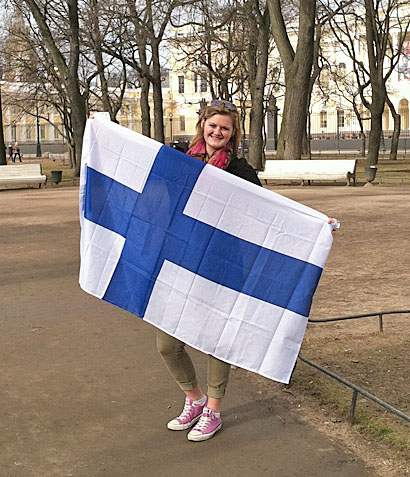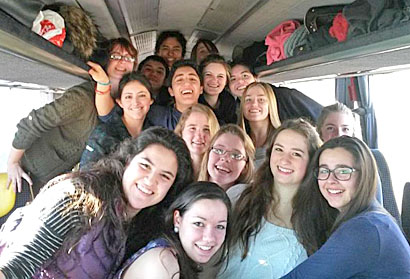-------------
We also have a Business Card Page. Click here.
----------------
Click on the logo below to reach the Arc of Schuyler County website.
-------
We also have a Business Card
Page. Click here.
Chelsea
reports from Finland![]()
A trip to Russia; and thoughts on life overseas
Chelsea Kennard, a 2013 graduate of Watkins Glen High School and a two-time member of The Odessa File-sponsored Top Drawer 24 team of outstanding high school student-athletes, has been spending this school year as an exchange student in Finland. This her third report on her experiences overseas.
 By
Chelsea Kennard
By
Chelsea Kennard
I have realized that I can always count on people who live abroad to huddle together, talking not just about their homelands, but about the experiences away from those homelands. These groups of people aren´t necessarily all from the same home countries, but often the mere experience of trading lands and cultures is enough to link us together and build the foundations of a friendship. Not only are these warm, notalgic conversations of the past, but they are also filled with the experiences that we are presently sharing.
Recently the exchange students, myself included, had the opportunity to visit Russia, on a tour of St. Petersburg. With about 85 exchange students participating, two buses set off, filled with the chaos of people from all over the world. St. Petersburg showcases a vivid history -- from czarist Russia through Communism to the present day. The second-largest city in Russia, it lives up to its reputation as the country's cultural capital, with astounding palaces, churches and museums.
It was an overwhelming, unforgettable trip, with a full schedule. The first day was dedicated to traveling. The trip from Helsinki, the capital of Finland, to St. Petersburg, Russia takes about six hours. We were able to capture a few sights in our camera lenses on the way, but we drove straight to the hotel, from the border, to get settled in and have a nice dinner as a group in the hotel. The following day, we were up for an early breakfast and ready to start the program.
First on the agenda was the Hermitage Museum, founded by Catherine the Great. This vast museum of art and culture contains almost three million items. We were told that if you spent one minute in front of every piece in the museum collections, it would take about six years to see everything. When you only have three hours to see as much as possible, it is easy to let yourself rush instead of taking the time or luxury to just simply admire. .
Next we ate lunch at a very traditional Russian restaurant, getting to taste cuisine much different from Finnish or our home countries' food. Then we completed a city tour of St. Petersburg, stopping at various noteworthy sites including St. Isaac's Cathedral, Peter and Paul's Fortress, the General Staff Building, The Church on Spilled Blood, St. Nicholas Naval Cathedral, and the Palace Square. Walking through St. Petersburg, everywhere you look there is a story worth knowing. These sites didn't appear out of nowhere, but instead are riddled with history, and it is evident that every age, every culture, every custom and tradition has its own character, its own weakness, its own strength, and its beauties and cruelties.
 Two
of the nights we were able to experience two very different cultural events,
the first a folklore show in the Nikolai Palace, filled with traditional
Russian songs and dances, and the second a classical Russian ballet. Both
were incredible and traditional, demonstrating events that are always
old, but at the same time ever new because they are always reviving --
born again in each new generation, to be lived and applied in a new and
particular way.
Two
of the nights we were able to experience two very different cultural events,
the first a folklore show in the Nikolai Palace, filled with traditional
Russian songs and dances, and the second a classical Russian ballet. Both
were incredible and traditional, demonstrating events that are always
old, but at the same time ever new because they are always reviving --
born again in each new generation, to be lived and applied in a new and
particular way.
We also visited Peter the Great's Museum of Anthropology and Ethnography, containing numerous advances in history and science from decades past. We stopped at numerous market places, including the market place in the city of Viborg, filled with homemade Russian souvenirs.
*****
Exchange trips are always refreshing, and it's an instant bond traveling with people who share similar feelings. We've become inseparable because we share so many of the same thoughts and emotions, and because we are experiencing one of the craziest years of our lives together.
The one thing that undoubtedly exists between all of us, something that lingers unspoken at all of our gatherings, is fear. There is a palpable fear in living in a new country, and though it was more intense in the first months of our stay, it never completely evaporates as time goes on. It simply changes. The anxiousness that was once concentrated on how we were going to make new friends, adjust, and master the nuances of the language has become the repeated question: “What am I missing?” As we settled into our new life and country, as time passed, our perception shifted from a question of how long we’ve been here to one of how long we’ve been gone. We realized that life back home has gone on without us -- although there is a certain amount of comfort and confidence that we've gained in tackling a new place, in seeking a new world. We have realized that we were capable of taking this leap and landing softly. But there are fears. People back home have grown up, they’ve moved, they’ve married, they’ve become completely different people — and so have we.
It’s hard to deny that the act of living in another country, in another language, has fundamentally changed us. Different parts of our personalities floated to the top, and we took on qualities, mannerisms, and opinions that define the new people around us. And there’s nothing wrong with that; it’s often part of the reason we left in the first place. We wanted to evolve, to change something within us, to put ourselves in an uncomfortable new situation that would force us into a new phase of our lives. Even with changes, I've realized that there are some traits that I cannot change about myself and are engraved in me from my American culture.
First, I have a very stereotypical American smile. Americans tend to smile with their whole face, not just showing teeth, but also smiling with our eyes. We also have a trigger-happy smile, ready on a whim. I made my host family laugh when I brought home my class picture here and they commented that they could instantly tell who the American was. I was the only student with a huge smile compared to the Finnish smile, which is often just looking at the camera with a straight face, or cracking a small smirk, which can be taken as a smile.
 Besides
smiling, Americans speak easily with strangers and often share personal
stories when engaging in small talk. In Finland, small talk is non-existent
and speaking with strangers is avoided. Finns do not engage in casual
talking. At the grocery store you don't find the cashier asking how the
customers are doing. The Finns are polite, but unnecessary speaking is
not done. They only talk when they have something that will benefit a
conversation. When they have nothing to say, they simply don't speak.
At first I felt very awkward in the silences. It wasn't natural to enchange
so few words, and I caught myself often trying to think of anything to
say to fill the silence. Now I am adjusted to this and I've found that
the silence is refreshing.
Besides
smiling, Americans speak easily with strangers and often share personal
stories when engaging in small talk. In Finland, small talk is non-existent
and speaking with strangers is avoided. Finns do not engage in casual
talking. At the grocery store you don't find the cashier asking how the
customers are doing. The Finns are polite, but unnecessary speaking is
not done. They only talk when they have something that will benefit a
conversation. When they have nothing to say, they simply don't speak.
At first I felt very awkward in the silences. It wasn't natural to enchange
so few words, and I caught myself often trying to think of anything to
say to fill the silence. Now I am adjusted to this and I've found that
the silence is refreshing.
The first time I had to ride the bus here, my host mom was giving me instructions so I would know what to expect. The last comment was, "Now when you go find your seat, choose a seat alone, and if there are no seats available, and you have to sit next to someone, then give them adequate space, and sit on the opposite side of your seat." I thought this was very strange advice, but upon stepping on the bus I saw that everyone was sitting alone; there was no friendly chatter between strangers.
I also found that I follow the stereotypical image of the loud American. Finns are very quiet and reserved, and when I'm walking down the street with another exchange student, our normal conversation will turn heads because we are noticeably louder then a majority of Finns.
Because Finns say something only if it needs to be said, naturally they say what they mean. In the U.S., depending on the situation and the person, generally we tend to keep our opinions to ourselves or omit some of the truth in order not to offend. I have realized that in American English the question "How are you?" is not actually a question, but a greeting. It is very rare that someone will actually tell you how they are doing, but instead might answer similarly: "Fine. How are you?" The Finnish equivalent is "Mitä kuuluu?" and you never ask this unless you have time to actually listen to how the other person has been doing, because you will learn about what they have done for possibly the past week.
One thing that a majority of people wonder about is the differences in food, which is strikingly different. Of course there are a few things that were very strange at first, like a traditional Easter food, Mämmi, which is made out of rye and traditionally eaten with milk or cream. Another very common food in Scandinavia, Finland included, is salty black licorice. It is an acquired taste and most Finns learn to love its sharp, sour flavors during childhood. One aspect of the culinary culture that is noticeably different is table manners. In the U.S. it is a social normality to eat with one hand, the other resting under the table, on your lap. Finns eat with both hands the whole meal -- something to which I have grown very accustomed.
 Over
the past eight months, I have realized that exchange is not solely centered
around completely and wholeheartedly adapting to a new culture; instead
it's about absorbing some of its aspects, and answering with some of your
own culture. Representing where you come from is part of the package.
Over
the past eight months, I have realized that exchange is not solely centered
around completely and wholeheartedly adapting to a new culture; instead
it's about absorbing some of its aspects, and answering with some of your
own culture. Representing where you come from is part of the package.
Walking streets alone just to take the time to learn my new home, I've spent hours with nothing but my own thoughts. I started asking myself questions and answering them, and taking in the day’s activities with a slowness and an appreciation that I’ve never before even attempted. Even just going to the grocery store — whether in an exciting new place, whether all by myself, whether with a new language — is a thrilling activity. And having to start from zero and rebuild everything, having to relearn how to live and carry out every day's activities like a child, has fundamentally altered me. Yes, the country and its people have had their own effect on who I am and what I think, but few things are more profound than just starting over with the basics and relying on yourself to build a life again. I have yet to meet a person who I didn’t find calmed by the experience.
All of the exchange students are looking at life, and at the two countries that shape each of us, and realizing that each of us is now two distinct people. As much as our countries represent and fulfill different parts of us and what we enjoy about life; as much as we have formed unbreakable bonds with people we love in both places; and as much as we feel truly at home in either one, we are split in two. For the rest of our lives -- or at least it feels this way -- we will spend our time longing for the other, and waiting until we can get back for at least a few weeks and dive back into the person we were here.
It takes so much to carve out a new life for yourself somewhere new, and it can’t die simply because you’ve moved over a few time zones. The people that took us into their country and became our new families, they aren’t going to mean any less to us when we’re far away.
To live in a new place is a beautiful, thrilling thing, and it shows you that you can be whoever you want to be. It can give you the gift of freedom, of new beginnings and memories, and of curiosity and excitement. But getting on that plane doesn't come without a price. We cannot be in two places at once, and both current and past exchange students lay awake on certain nights and think of all the things they are missing out on back home.
Photos in text:
From top: Chelsea in the city center of St. Petersburg with the Finnish flag; exchange students on the bus ride to St. Petersburg; Chelsea and fellow students on one of the many St. Petersburg bridges; exchange students in front of the Hermitage Museum.
To see Part 1 of Chelsea's account, visit SchuyLines.
To see Part 2 of Chelsea's account, click here.
Charles Haeffner
P.O. Box 365
Odessa, New York 14869
